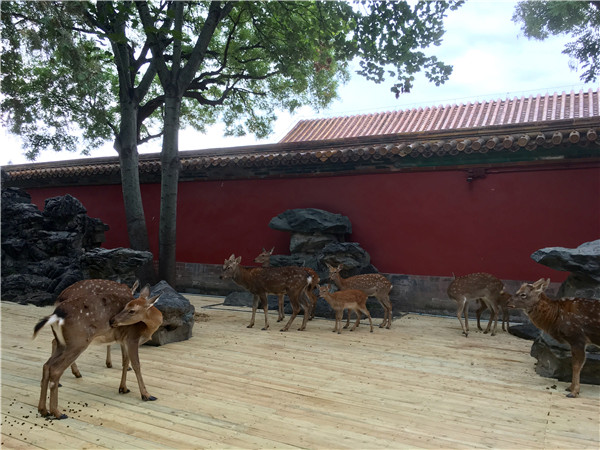 |
|
Nine sika deer were recently ushered into the Cining Gong Garden as part of an exhibition on deer-related cultural relics, which opened at the Palace Museum in Beijing. [Photo by Wang Kaihao/China Daily] |
According to Liu Zilong, head of the administration office of Chengde Mountain Resort, hunting used to be a tradition among the Manchu rulers of the dynasty to remember their nomadic origins.
In early fall, the Qing emperors led hundreds of attendants to hunt in Mulan Weichang, a grassland area in Chengde.
"Deer-hunting in the early morning was a key part," says Liu. "It was also a way for the Qing rulers to enforce military discipline."
The ritual became a routine during the reign of Qianlong and his son Emperor Jiaqing.
The Chengde Mountain Resort has had wild sika deer since imperial times.
And though the nine deer have been tamed, Liu says that feeding them is not allowed in the Forbidden City to ensure their safety.
Wang Yamin, a deputy director at the Palace Museum, says: "There was a long tradition raising deer in imperial China."
He says that the Forbidden City also had a deer garden in the Qing era.
The nine deer are scheduled to be in the Cining Gong Garden until the end of the exhibition in February 2018.
As for the future, no plans have been made, but the fact that they are there reflects a new view in the museum about cultural relics and living creatures, says Wang. "It's a better way to bring cultural relics closer to the people."
Last year, when two cultural relic exhibitions, respectively, on the peony and the chrysanthemum, were held at the Palace Museum, real flowers were brought into the facility.
If you go
8:30 am-5 pm, through Oct 31; 8:30 am-4:30 pm, starting from Nov 1; Mondays closed; through February, 2018. Palace of Eternal Longevity, Palace Museum. 4 Jingshan Qianjie, Dongcheng district, Beijing. Visit www.dpm.org.cn for more information.